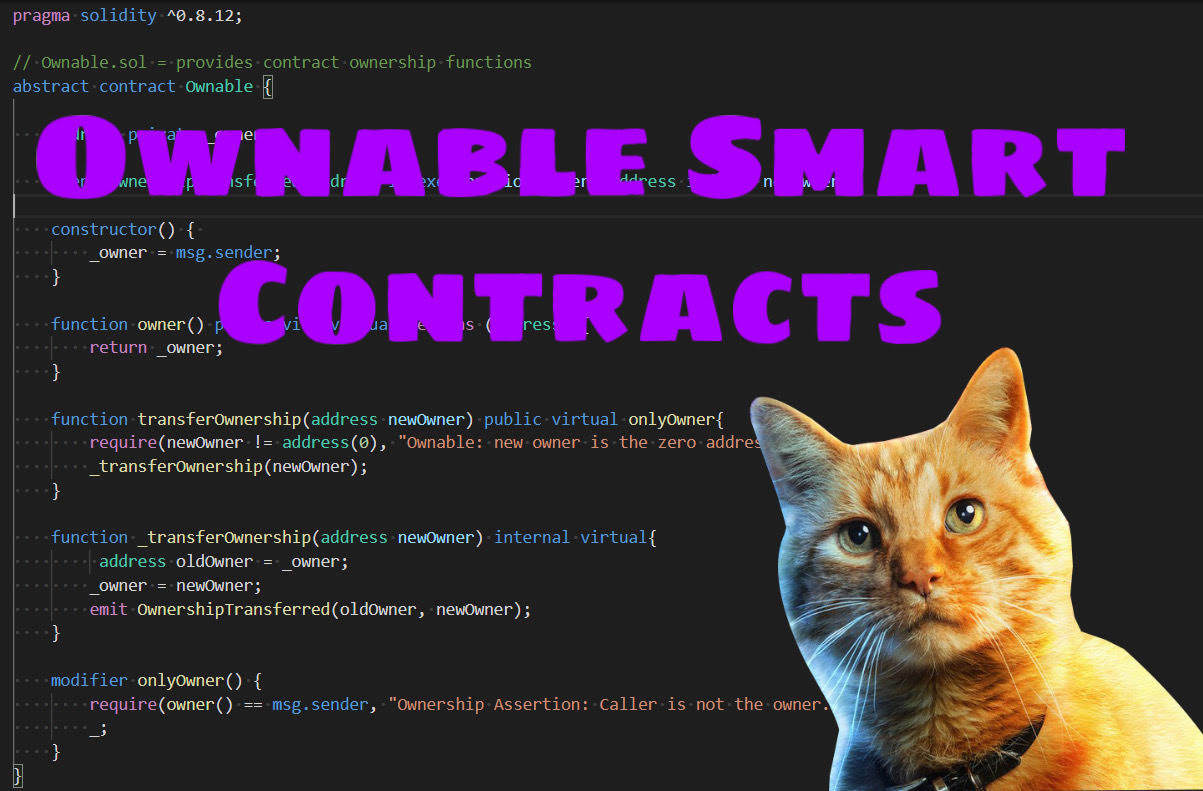Solidity Contract Ownership: Truffle Deployment Guide
Learn how Solidity contract ownership works with Truffle and identify the owner of deployed contracts for secure and controlled dApp development.
Learn how Solidity contract ownership works with Truffle and identify the owner of deployed contracts for secure and controlled dApp development.
When deploying smart contracts using Truffle, understanding contract ownership is crucial. The account used for deployment, typically your development environment's default account, becomes the initial owner. This has significant implications, especially if your contract utilizes the Ownable pattern from OpenZeppelin, granting the owner special privileges.
When you deploy a smart contract using Truffle, the account that you use to execute the truffle migrate command becomes the owner of that contract. This is because Truffle uses your development environment's default account for deployment unless specified otherwise.
truffle migrate --network <network-name>
You can customize which account deploys the contract by specifying a different network in your truffle-config.js file and associating it with a specific private key or mnemonic.
module.exports = {
networks: {
development: {
host: "127.0.0.1",
port: 7545,
network_id: "*",
},
custom_network: {
provider: () => {
return new HDWalletProvider(
"your mnemonic",
"https://your-network-provider"
);
},
network_id: "*",
},
},
};Remember that deploying contracts to a live network requires real Ether for gas. Ensure you have sufficient funds in the account used for deployment.
If your contract uses the Ownable pattern from OpenZeppelin, the deployer account will initially hold the owner role. This role typically grants special permissions for modifying contract state or settings.
import "@openzeppelin/contracts/access/Ownable.sol";
contract MyContract is Ownable {
// ... your contract logic
}You can transfer ownership later using the transferOwnership() function provided by the Ownable contract.
function transferOwnership(address newOwner) public onlyOwner {
_transferOwnership(newOwner);
}Always double-check the ownership structure of your contracts after deployment, especially when interacting with live networks, to prevent unauthorized access or control.
This codebase is a Truffle project demonstrating the deployment of a smart contract that utilizes OpenZeppelin's Ownable contract for access control. The contract, named MyContract, allows only the owner to update a message stored within it. The project includes scripts for deploying to both a local development network and a custom network using an HDWalletProvider. The provided JavaScript code snippets demonstrate how to interact with the deployed contract, including checking the current owner and transferring ownership to a new address. Remember to replace placeholder values with your actual configuration and never commit sensitive information like private keys to version control.
This example demonstrates deploying a simple contract with OpenZeppelin's Ownable and transferring ownership.
1. Project Setup:
mkdir my-ownable-contract
cd my-ownable-contract
truffle init
npm install @openzeppelin/contracts2. Contract (contracts/MyContract.sol):
pragma solidity ^0.8.0;
import "@openzeppelin/contracts/access/Ownable.sol";
contract MyContract is Ownable {
string public message;
constructor(string memory initialMessage) {
message = initialMessage;
}
function updateMessage(string memory newMessage) public onlyOwner {
message = newMessage;
}
}3. Migrations (migrations/2_deploy_contract.js):
const MyContract = artifacts.require("MyContract");
module.exports = function (deployer) {
deployer.deploy(MyContract, "Initial Message");
};4. Truffle Config (truffle-config.js):
module.exports = {
networks: {
development: {
host: "127.0.0.1",
port: 7545,
network_id: "*",
},
// Example custom network with HDWalletProvider
custom_network: {
provider: () => {
const HDWalletProvider = require("@truffle/hdwallet-provider");
return new HDWalletProvider(
"your mnemonic",
"https://your-network-provider"
);
},
network_id: "*",
},
},
compilers: {
solc: {
version: "^0.8.0", // Fetch exact version from pragma
},
},
};5. Deployment:
truffle migratetruffle migrate --network custom_network6. Interacting (using Truffle console):
// 1. Get contract instance
const instance = await MyContract.deployed();
// 2. Check initial owner (should be deployer)
const initialOwner = await instance.owner();
console.log("Initial Owner:", initialOwner);
// 3. Prepare new owner address
const newOwner = "0x..."; // Replace with actual address
// 4. Transfer ownership (only callable by current owner)
await instance.transferOwnership(newOwner);
// 5. Verify new owner
const currentOwner = await instance.owner();
console.log("Current Owner:", currentOwner);Important Notes:
truffle-config.js and interaction script.Security:
Ownable is a basic access control mechanism. For more complex scenarios, explore OpenZeppelin's AccessControl or Roles contracts for fine-grained permissions.Best Practices:
truffle estimate-gas. Optimize your contract's code for gas efficiency to minimize transaction fees.Advanced Concepts:
UpgradeableProxy) to enable upgrading your contract's logic after deployment, mitigating the risks of immutable code.Troubleshooting:
truffle-config.js for correct network settings, provider URLs, and network IDs.Remember: Deploying smart contracts involves inherent risks. Thoroughly test, review, and understand the implications of your code and ownership structure before deploying to a live network.
| Feature | Description |
|---|---|
| Default Deployer Account | When deploying with truffle migrate, the account used to execute the command becomes the contract owner by default. This is typically your development environment's default account. |
| Customizing Deployer Account | You can specify a different account for deployment by: 1. Defining a custom network in your truffle-config.js file. 2. Associating this network with a specific private key or mnemonic. |
| Live Network Deployment | Deploying to a live network requires real Ether for gas. Ensure sufficient funds in the deployment account. |
| OpenZeppelin Ownable Pattern | If your contract uses OpenZeppelin's Ownable, the deployer account initially holds the owner role, granting special permissions. |
| Transferring Ownership | Ownership can be transferred using the transferOwnership() function provided by the Ownable contract. |
| Security Best Practice | Always verify the ownership structure of your deployed contracts, especially on live networks, to prevent unauthorized access. |
Understanding contract ownership is crucial when deploying smart contracts using Truffle. The account used for deployment, often your development environment's default, becomes the initial owner, wielding significant control, especially with OpenZeppelin's Ownable pattern. This ownership can be transferred using the transferOwnership() function. Always double-check the ownership of your deployed contracts, especially on live networks, to prevent unauthorized access. Consider security implications, best practices, and advanced concepts like proxy patterns and multi-sig ownership for robust and secure smart contract deployments. Remember to thoroughly test and review your code before deploying to a live network.
 Burning/Deleting contract deployed using truffle - Moralis General ... | I am following the Ultimate NFT Programming Tutorial Course video by Filip. In the tutorial he uses remix to deploy the contract to the rinkeby testnet. I used truffle. I am now trying to change the contract and trying to deploy by changing the secret key in the dotenv file which is used by truffle-hdwallet-provider. I do not know if this is the appropriate forum to ask this but how do I delete the contract already pushed to the rinkeby network using my address(owner) [in order to burn/disca...
Burning/Deleting contract deployed using truffle - Moralis General ... | I am following the Ultimate NFT Programming Tutorial Course video by Filip. In the tutorial he uses remix to deploy the contract to the rinkeby testnet. I used truffle. I am now trying to change the contract and trying to deploy by changing the secret key in the dotenv file which is used by truffle-hdwallet-provider. I do not know if this is the appropriate forum to ask this but how do I delete the contract already pushed to the rinkeby network using my address(owner) [in order to burn/disca... My first taste of building a Web3 app with Solidity, React and ... | Lately I have a lot of time on my hands. Centralized exchanges are blowing up everywhere, not doing so great during these difficult times…
My first taste of building a Web3 app with Solidity, React and ... | Lately I have a lot of time on my hands. Centralized exchanges are blowing up everywhere, not doing so great during these difficult times… Smart contract deploy error - Contracts - OpenZeppelin Forum | Hi, I'm a beginner at creating contracts, I've error when I deploy my contract with truffle and ganache-cli: "Owo" hit a require or revert statement somewhere in its constructor. Try: * Verifying that your constructor params satisfy all require conditions. * Adding reason strings to your require statements. this is my constructor code: constructor (address payable charityWalletAddress) public { _charityWalletAddress = charityWalletAddress; _rOwned[_msgSender()] = _...
Smart contract deploy error - Contracts - OpenZeppelin Forum | Hi, I'm a beginner at creating contracts, I've error when I deploy my contract with truffle and ganache-cli: "Owo" hit a require or revert statement somewhere in its constructor. Try: * Verifying that your constructor params satisfy all require conditions. * Adding reason strings to your require statements. this is my constructor code: constructor (address payable charityWalletAddress) public { _charityWalletAddress = charityWalletAddress; _rOwned[_msgSender()] = _... Testing your smart contract with Truffle - DEV Community | Learn how to setup a testing environment and write tests for your contracts.
Testing your smart contract with Truffle - DEV Community | Learn how to setup a testing environment and write tests for your contracts. Verifying Contract. Etherscan Testnet. Remix with import links from ... | First post so I’m sure I’m formatting this wrong. apologies. Was looking for a simple ERC20 with some burning options by owner. Can deploy contract for testnet. (have tried about 5 different “test” contracts all with similar code) but always having issues verifying. Have looked through most of the past articles on OpenZeppelin but can’t seem to find the right combination. 💻 Environment Remix… simple code with some imports of 4.1 OpenZeppelin contracts mostly. I’ve tried linking, re...
Verifying Contract. Etherscan Testnet. Remix with import links from ... | First post so I’m sure I’m formatting this wrong. apologies. Was looking for a simple ERC20 with some burning options by owner. Can deploy contract for testnet. (have tried about 5 different “test” contracts all with similar code) but always having issues verifying. Have looked through most of the past articles on OpenZeppelin but can’t seem to find the right combination. 💻 Environment Remix… simple code with some imports of 4.1 OpenZeppelin contracts mostly. I’ve tried linking, re... Creating an Ownable Smart Contract in Solidity for Ethereum ... | Mar 22, 2022 ... When first deployed, the application should automatically assign ownership of the contract ... using truffle using the truffle migrate CLI ...
Creating an Ownable Smart Contract in Solidity for Ethereum ... | Mar 22, 2022 ... When first deployed, the application should automatically assign ownership of the contract ... using truffle using the truffle migrate CLI ...